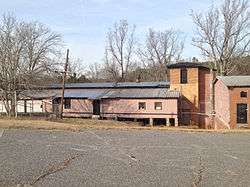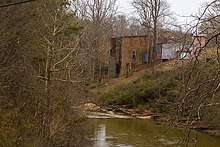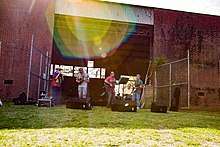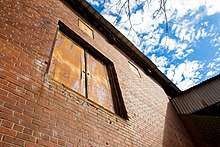Double Shoals Cotton Mill
Double Shoals Cotton Mill is currently under renovations for use as an event venue. Other names for the mill were the Double Shoals Manufacturing Company and Lucky Stride Yarn Mill, is a historic cotton mill located at Double Shoals, Cleveland County, North Carolina, which is just north of Shelby, North Carolina. The cotton mill was built about 1874, with additions made in 1965 and in the 1970s. It is a 2 1/2-story, brick building with a shallow-pitched, side-gable-roof and Italianate style design elements. Also on the property are a contributing mill race and dam, built about 1880. The building apparently ceased all operation as a mill in the mid-1980s.[2]

Double Shoals Cotton Mill | |
 | |
  | |
| Location | 199 Old Mill Rd., Shelby, North Carolina |
|---|---|
| Coordinates | 35°22′51″N 81°32′43″W |
| Area | 15 acres (6.1 ha) |
| Built | c. 1874 |
| Architectural style | Italianate, Slow-burning construction |
| NRHP reference No. | 08000775[1] |
| Added to NRHP | March 24, 2009 |







It was listed on the National Register of Historic Places in 2009.[1]
In 2016 work began to transform the once abandoned mill into something special. The first action was to convert the lower level for use as a custom car shop, Fabbit Customs. Then the outdoor spaces began taking space for use as event space. Now the upper level is being converted into space for an art studio and event space.
References
- "National Register Information System". National Register of Historic Places. National Park Service. July 9, 2010.
- Sybil Argintar (February 2009). "Double Shoals Cotton Mill" (pdf). National Register of Historic Places - Nomination and Inventory. North Carolina State Historic Preservation Office. Retrieved 2014-08-01.

